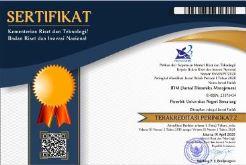Pricing Strategies and Implementation Promotion Strategies to Improve Customer Loyalty
Abstract
Keywords
Full Text:
PDFReferences
Anggia, T. R., Kawet, L & Ogi, I. 2015. Analisis Pengaruh Strategi Promosi, Harga dan Kepuasan terhadap Loyalitas Konsumen Surat Kabar Manado Post. Jurnal Riset Ekonomi, Manajemen, Bisnis dan Akuntansi. 3 (2): 1041-1050
Amron, 2014. Kualitas Produk, Harga, Promosi dan Distribusi terhadap Loyalitas Konsumen handphone Samsung di Semarang. Jurnal Manajemen Pemasaran. 132-135
Ardhani, A. P. 2007. Pengaruh Switching Cost Sebagai Pemoderasi Hubungan Antara Kepuasan dan Loyalitas Konsumen. Jurnal Riset Manajemen &Bisnis. 2 (2): 155-171.
Aspizain, C. 2016. The Effects of Service Quality and Corporate Rebranding on Brand Image, Customer Satisfaction, Brand Equity and Customer Loyalty: Study in Advertising Company Attvone. Russian Journal of Agricultural And Socio-Economic Sciences. 12 (60): 209-217.
Cawsey, T & Rowley, J. 2016. Social Media Brand Building Strategies in B2B Companies. Marketing Intelligence & Planning. 34 (6): 754-776.
Craven, M. 1994. Marketing Knowledge Management. 4rd Edition. London: Scienetics Economics Association.
Durianto, D., Sugiarto & Sitinjak, T. 2001. Strategi Menaklukkan Pasar melalui Riset Ekuitas dan Perilaku Merek. Jakarta: Gramedia.
Gilbert, D. 2003. Retailing Marketing Management. 2th Edition. England, Endinburgh Gate: Pearson Educated Limited.
Harini. 2008. Makro Ekonomi Pengantar. Jakarta: PT Gramedia Pustaka Utama.
Hänninen, N & Karjaluoto, H. 2017. The Effect of Marketing Communication on Business Relationship Loyalty. Marketing Intelligence and Planning. 35 (4): 458-472.
Karundeng, F. P. 2013. Service Quality and Satisfaction Influence on Consumer Loyalty at Restaurant Sharon Wanea Manado. Jurnal Riset Ekonomi, Manajemen, Bisnis dan Akuntansi. 1 (3): 14-26.
Khan, M. N., Rasheed, S., Islam, F., Ahmed, H. I & Rizwan, M. 2016. Corporate Branding, Emotional Attachment and Brand Loyalty: The Case of Luxury Fashion Branding. International Journal of Scientific and Research Publications. 6 (5): 151-159.
Koo, W & Kim, Y. K. 2013. Impacts of Store Environmental Cues on Store Love and Loyalty: Single-Brand Apparel Retailers. Journal of International Consumer Marketing. 25 (2): 94-106.
Kotler, P. 2015. Framework for marketing management. Pearson Education India.
Kuncoro, A & Rusdianto, H. 2016. The Influence of Entrepreneurship Subject on Students’ Interest in Entrepreneurship with Hidden Curriculum as the Intervening Variable. Dinamika Pendidikan. 11 (1): 58-66.
Liao, Y. W., Wang, Y. S & Yeh, C. H. 2014. Exploring the Relationship between Intentional and Behavioral Loyalty in the Context of E-tailing. Internet Research. 24 (5): 668-686.
Luo, W & Chung, Q. B. 2015. Retailer Reputation and Online Pricing Strategy. Journal of Computer Information Systems. 50 (4): 50-56.
Machfoedz, M. 2005. Pengantar Pemasaran Modern. Yogyakarta: UPP AMP YKPN
Mulyana & Sutapa . 2016. The Impact of Entrepreneurial Orientation and Collaborative Networks on Creative Industries Performance. Journal Dinamika Manajemen. 7 (2): 166-181.
Pacheco, B. G & Rahman, A. (2015). Effects of Sales Promotion Type and Promotion Depth on Consumer Perceptions: the Moderating Role of Retailer Reputation.The International Review of Retail. Distribution and Consumer Research. 25 (1): 72-86.
Panjaitan, H. 2017. Impact of Satisfaction and Customer Engagement as Intervening Variable on Customer Loyalty: Study at XL Resto & Cafe Surabaya Indonesia. International Journal of Business and Management Invention. 6 (9): 41-48.
Pondaag, T. O & Soegoto, A. S. 2016. Evaluasi Strategi Promosi dan Penjualan Terhadap Keunggulan Bersaing pada PT. Astragraphia,Tbk Cabang Manado. Jurnal Riset Ekonomi, Manajemen, Bisnis dan Akuntansi. 4 (2): 133-143.
Putri, V. W & Yuniawan, A. 2016. Organizational Effectiveness: Social Capital and Competitive Advantage Approach. Jurnal Dinamika Manajemen. 7 (1): 76-90.
Rai, A & Srivastava, M. 2013. The Antecedents of Customer Loyalty: an Empirical Investigation in Life Insurance Context. Journal of Competitiveness. 5 (2): 139-163.
Rusdianto, H & Ibrahim, C. 2016. Pengaruh Produk Bank Syariah terhadap Minat Menabung dengan Persepsi Masyarakat Sebagai Variabel Moderating di Pati. Equilibrium: Jurnal Ekonomi Syariah. 4 (1): 43-61.
Shabastian, M & Samuel, H. 2013 Pengaruh Strategi Harga dan Strategi Produk Terhadap Brand Loyalty di Tator Café Surabaya Town Square. Jurnal Manajemen Pemasaran. 1 (1): 1-9.
Sumadi, S & Soliha, E. 2015. The Effect of Bank Image and Trust on Loyality Mediated by Customer Satisfaction. Jurnal Dinamika Manajemen. 6 (2): 121-132.
Suwono, L & Sihombing, S. 2016. Factors Affecting Customer Loyalty of Fitness Centers: An Empirical Study. Jurnal Dinamika Manajemen. 7 (1): 45-55.
Syafei , R. 2000. Fiqih Muamalah, Bandung: Pustaka Setia.
Taiminen, H & Karjaluoto, H. 2015. The Usage of Digital Marketing Channels in SMEs. Journal of Small Business and Enterprise Development. 22 (4): 633-651.
Witiastuti, R. S., Putri, V. W., Wijayanto, A & Sudarma, K. 2017. Improvement Efforts in Marketing Value Drivers through E-Marketing for Small and Medium-Sized Enterprises (SMEs) in Superior Processed Products in Semarang Regency, Indonesia. International Journal of the Computer, the Internet and Management. 25 (1): 21-24.
Wu, C. C. 2011. The Impact of Hospital Brand Image on Service Quality, Patient Satisfaction and Loyalty. African Journal of Business Management. 5 (12): 4873-4882.
Xiao, B., Huang, M & Barnes, A. J. 2015. Network Closure among Sellers and Buyers in Social Commerce Community. Electronic Commerce Research and Applications. 14(6): 641-653.
Yuniawan, A., Putri, V. W & Udin. 2017. Developing an alternAtive model for the relationship among social Capital, adaptive-Integrative Leadership, competitive Advantage and organizational effectiveness. International Journal of Civil Engineering and Technology. 8(11): 52-60.
Zhang, K. Z., Benyoucef, M & Zhao, S. J. 2016. Building Brand Loyalty in Social Commerce: the Case of Brand Microblogs. Electronic Commerce Research and Applications. 15: 14-25.
View Counter: Abstract - 6771 and PDF - 3318
Refbacks
- There are currently no refbacks.





